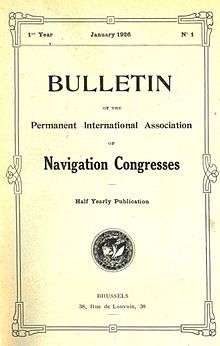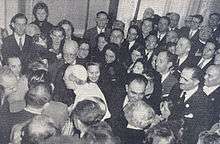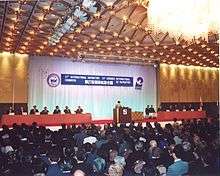World Association for Waterborne Transport Infrastructure
 | |
| Motto | Navigare necesse. |
|---|---|
| Formation | May 25, 1885 |
| Type | Engineering Society |
| Headquarters | Brussels, Belgium |
Membership | 2,100 |
Official language | English, French |
President | Geoffroy Caude (since 2011) |
Staff | 5 |
| Website |
www |
The World Association for Waterborne Transport Infrastructure (PIANC) is an international organisation founded in 1885[1] which is responsible for addressing topics and advising on standards in the field of navigable waterway traffic on canals, rivers and in ports. It is headquartered in Brussels in offices provided by the Flemish government of Belgium. Its earlier names were the Association Internationale Permanente des Congres de Navigation (AIPCN) until 1921, then as the Permanent International Association of Navigation Congresses (PIANC). It is additionally known as the International Navigation Association (French: Association Internationale de Navigation).
History
On 25 May 1885, the first Inland Navigation Congress was held in Brussels, providing a forum for an international debate on these questions. After some years, the Inland Navigation Congress merged with the Ocean Navigation Congress and the International Navigation Congress was born. During the Congress in Paris, 1900, a Permanent International Commission for the Navigation Congresses was set up. Two years later statutes were adopted. PIANC was a fact. Congresses are held every four years and are spread all over the world. In 1926 it was decided to release a Bulletin every half year to promote the contact between members. The Bulletin still exists, but now in the form of an electronic Magazine. A decision made in 1979 was of utmost importance: to establish Permanent Technical Commissions and Working Groups under the umbrella of the Technical Commissions. The first Working Group report was issued in 1983 and over 100 others followed suit. PIANC changed considerably over the years, from an Association organising a Congress every four years, to an Association setting technical standards and publishing high ranking reports.




Organization
The association is composed of qualifying members,[2] subscribing members and Honorary Members, who can be both legal and natural persons. The qualifying members of the association, having the right to vote in the general assembly, are:
- National governments;
- Regional governments of a national state;
- National sections or national bodies from countries of which the governments are not (any more) a qualifying member; these national sections or national bodies shall obtain the same rights and duties as governmental members after approval of their membership by the General Assembly (GA);
- intergovernmental organisations
PIANC operates with a President, a General Secretary and Vice-Presidents representing the main areas of the world. The main decision-making body is the General Assembly.
World Congress
PIANC organizes the World Congress every four years in different areas of the world. Other periodic main events are: Smart Rivers, focused on inland navigation infrastructure, the COPEDEC congresses, that are held in countries in transition, the Mediterranean Days of Coastal and Port Engineering, focused on the Mediterranean area, "port of history, port of the World".
Commissions
The main activities of PIANC regard the setting up and management of international experts working groups for the preparation of technical reports and guidelines in the fields of the waterborne navigation infrastructure design, construction and management,[3] the organization of congresses and events at an international level, the recognition of awards to the excellences in the fields of interest. To do this PIANC has the following technical commissions of international experts:
- Inland Navigation Commission (InCom)
- Environmental Commission (EnviCom)
- Maritime Navigation Commission (MarCom)
- Recreational Navigation Commission (RecCom)
The other PIANC strategic commissions are:
- International Cooperation Commission (CoCom)
- Finance Commission (FinCom)
- Promotion Commission (ProCom)
- Young Professionals Commission (YPCom)
Overall supervision of all Commissions is provided by the Executive Committee (ExCom).
Inland
The Inland Navigation Commission (InCom) is in charge of the activities of PIANC in the field of inland waterways in co-operation with MarCom, ReCom and EnviCom. InCom will network with other international organisations/commissions to reach PIANC’s strategic goals.
Environmental
The Environmental Commission (EnviCom) is responsible for dealing with broad and very specific environmental issues of interest to PIANC and representing PIANC in the international organisations dealing with these issues such as the London Convention, OSPAR, WODA and the EU. It is further recognised that the site-specific environmental impacts of inland navigation or maritime activities are partnered and/or dealt with respectively by InCom and MarCom. Furthermore, EnviCom is responsible for broad and generic environmental issues that cross-cut all PIANC areas. EnviCom is networking with other navigation related interests and has communications with non-traditional groups dealing with environmental affairs and training needs. The Commission also initiates efforts to enhance PIANC membership with environmental specialists.
Maritime
The Maritime Navigation Commission (MarCom) is responsible for dealing with maritime ports and seaways issues of interest to PIANC. MarCom co-operates with other Commissions when issues can be seen to have a broader perspective, for example when they also have an environmental or inland impact. MarCom also co-operates and communicates with other international organisations such as IMO, IAPH, WODA, etc.
Recreational
The Recreational Navigation Commission (RecCom) has been established to deal with aspects directly related to sport and recreational navigation, to develop aids for this kind of navigation and facilitate its integration among the other types of navigation (commercial and fishing). RecCom works closely together with other organisations such as the International Council of Marine Industry Associations (ICOMIA). The RecCom is composed by about fifteen experts coming from all the continents, and manages the working groups of experts for the preparation of the technical reports and guidelines. Every year the Commission assigns the PIANC Marina Excellence Design "Jack Nichol" Award. The Commission started also the PIANC Marina Designer Training Program (MDTP), with the aim of organizing specific courses for Marina Designers.
Recreational classification
The boat classification sizes RA, RB, RC and RD were created to cover recreational boats falling below the Classification of European Inland Waterways ("CEMT") dimensions.[4] The proposal to extend the CEMT classification was adopted by United Nations Economic Commission for Europe resolution 52.[5][6]
Awards
PIANC established and manage, through the Technical Commissions, the following international awards:
- PIANC De Paepe-Willems Award
- PIANC Marina Excellence Design "Jack Nichol" Award (MEDA)
- PIANC YP Award
- PIANC Working with Nature Award
The different PIANC awards have specific rules and regulations.
References
- ↑ Pepper, Chrissie (25 May 2007). "Joint response of the Institution of Civil Engineers and PIANC to the Department for the Environment, Food and Rural Affairs Hydromorphology consultation" (letter). Institution of Civil Engineers. Retrieved 11 July 2012.
- ↑ "Procedure for Qualifying Membership Application". PIANC website. PIANC. Retrieved 3 October 2013.
- ↑ "Browse Technical reports". PIANC website. PIANC. Retrieved 3 October 2013.
- ↑ RecCom Working Group 8 (2000). Standards for the Use of Inland Waterways by Recreational Craft (Report). PIANC. p. 30–32. ISBN 2-87223-115-3. Retrieved 11 July 2012.
- ↑ Edwards-May, David (3 July 2007). Classification of Recreational waterways (PDF) (Report). Lille: Stichting Recreatietoervaart Nederland. Retrieved 11 July 2012.
- ↑ Working Party on Inland Water Transport (19 November 2004). "Resolution No.52" (PDF). European Recreational Inland Navigation Network. Geneva: Economic Commission for Europe Inland Transport Committee.